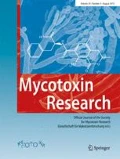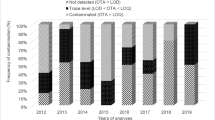Abstract
Ochratoxin A is one of the most diffused mycotoxin present in a large spectrum of food commodities, mainly produced by Aspergillus ochraceus, Aspergillus carbonarius, Aspergillus niger and Penicillium verrucosum. EU has set maximum limits for a number of matrices such as cereals, wine, spices and liquorice, whilst other commodities such as beer and meat products that are susceptible of OTA contamination and are largely consumed are not included. In 2013, within the framework of the Regulation (EC) 882/2004 on official controls, the European Commission issued the mandate M/520 regarding the standardisation for methods of analysis for mycotoxins in food to the European Committee for Standardisation. Of the 11 priorities of the mandate, the one on “HPLC determination of OTA in meat, meat products and edible offal” was assigned to the Italian National Reference Laboratory for feed and food. The method was single-laboratory validated, and all the performance characteristics of the method were compliant with the corresponding reference values indicated in Regulation (EC) n. 401/2006. The method was applied to characterise a set of 5 pork-based materials (ham, kidney, liver and canned chopped pork) to be used for an inter-laboratory method validation study. Three ham materials (levels of contamination of 0.77, 2.22 and 12.3 μg/kg, respectively), one liver material (contamination level of 2.80 μg/kg) and one chopped pork meat (contamination level of 0.66 μg/kg) were tested for homogeneity and stability.

Similar content being viewed by others
References
Battacone G, Nudda A, Pulina G (2010) Effects of Ochratoxin a on livestock production. Toxins 2(7):1796–1824
Brera C, Pannunzi E, Guarino C, Debegnach F, Gregori E, De Santis B (2014) Ochratoxin A determination in cured ham by high performance liquid chromatography fluorescence detection and ultra performance liquid chromatography tandem mass spectrometry: a comparative study. J Liq Chrom Relat Technol 37(14):2036–2045
Castegnaro M, Canadas D, Vrabcheva T, Petkova-Bocharova T, Chernozemsky IN, Pfohl-Leszkowicz A (2006) Balkan endemic nephropathy: role of ochratoxins A through biomarkers. Mol Nutr Food Res 50(6):519–529
Council for Agricultural Science and Technology [CAST] (2003) Mycotoxins: Risks in Plant, Animal, and Human Systems, Task Force Report No. 139 January: 36–47
EURACHEM/CITAC (2012) Guide Quantifying Uncertainty in Analytical Measurement Third Edition Editors S Ellison LR, Williams A(UK). https://www.eurachem.org/images/stories/Guides/pdf/QUAM2012_P1.pdf. Accessed 23 August 2019
European Commission [EC] (2004) Commission regulation (EC) no 882/2004 of the European Parliament and of the council of 29 April 2004 on official controls performed to ensure the verification of compliance with feed and food law, animal health and animal welfare rules. OffJ Eur Union L165:1–141
European Commission [EC] (2006a) Commission Regulation (EC) No 1881/2006 of 19 December 2006 setting maximum levels for certain contaminants in foodstuffs. OffJ Eur Union L364:5–24
European Commission [EC] (2006b) Commission regulation (EC) no 401/2006 of 23 February 2006 laying down the methods of sampling and analysis for the official control of the levels of mycotoxins in foodstuffs. OffJ Eur Union L70:12–34
European Food Safety Authority [EFSA] (2006) EFSA Panel on Contaminant in the Food Chain; Opinion of the Scientific panel on contaminants in the food chain [CONTAM] related to ochratoxin A in food. EFSA J 4(6):365 1–56
International Agency for research on Cancer [IARC] (1993) IARC Monographs on the evaluation of carcinogenic risks to humans. Some naturally occurring substances: food items and constituents, heterocyclic aromatic amines and mycotoxins, Volume 56. IARC Lyon, France, pp 489–521
Joint FAO/WHO Expert Committee on Food Additives [JECFA] (2007) Evaluation of certain food additives and contaminants (Sixty-eighth report of the Joint.FAO/WHO Expert Committee on Food Additives). WHO Technical Report Series,947, 2007: 159–180
Krogh P, Hald B, Plestina R, Ceović S (1977) Balkan (endemic) nephropathy and foodborn ochratoxin A: preliminary results of a survey of foodstuffs. Acta Pathol Microbiol Scand B 85(3):238–240
Magnusson B, Örnemark U (eds.) (2014) Eurachem guide: the fitness for purpose of analytical methods – a laboratory guide to method validation and related topics, (2nd ed. 2014)
Mally A, Dekant W (2005) DNA adduct formation by ochratoxin A: review of the available evidence. Food Addit Contam 22(1):65–74
Merla C, Andreoli G, Garino C, Vicari N, Tosi G, Guglielminetti ML, Moretti A, Biancardi A, Arlorio M, Fabbi M (2018) Monitoring of ochratoxin A and ochratoxin-producing fungi in traditional salami manufactured in Northern Italy. Mycotoxin Res 34(2):107–116
Ministero della Sanità. Cicolare 9 giugno 1999, n. 10. Direttive in materia di controllo ufficiale sui prodotti alimentari: valori massimi ammissibili di micotossine nelle derrate alimentari di origine nazionale, comunitaria e Paesi terzi. Gazzetta Ufficiale Repubblica Italiana. Serie Generale n.135 del 11-06-1999: 52–57
O’Brien E, Dietrich DR (2005) Ochratoxin A: the continuing enigma. Crit Rev Toxicol 35(1):33–60
Perši N, Pleadin J, Kovačević D, Scortichini G, Milone S (2014) Ochratoxin A in raw materials and cooked meat products made from OTA-treated pigs. Meat Sci 96(1):203–210
Pfohl-Leszkowicz A, Manderville RA (2007) Ochratoxin A: an overview on toxicity and carcinogenicity in animals and humans. Mol. Nutr Food Res 51:61–99
Pietri A, Bertuzzi T, Gualla A, Piva G (2006) Occurrence of ochratoxin A in raw ham muscles and in pork products from northern Italy. Ital J Food Sci 1:1–8
Pohland AE, Neshim S, Friedman L (1992) Ochratoxin A: a review. Pure Appl Chem 64(7):1029–1046
Rodríguez M, Martín A, Delgado J, Córdoba JJ (2012) Presence of ochratoxin A on the surface of dry-cured Iberian ham after initial fungal growth in the drying stage. Meat Sci 92(4):728–734
Thompson M, Ellison S, Wood R (2006) The international harmonized protocol for the proficiency testing of analytical chemistry laboratories. Pure Appl Chem 78(1):145–196
Wenzl T, Haedrich J, Schaechtele A, Robouch P, Stroka J (2016) Guidance document on the estimation of LOD and LOQ for measurements in the field of contaminants in feed and food; EUR 28099, Publications Office of the European Union, Luxembourg, 2016, ISBN 978-92-79-61768-3; https://doi.org/10.2787/8931
Acknowledgements
The authors thank M. Cristina Barea Toscan for project administrative management and Giuliana Verrone for technical assistance.
Funding
This work was supported by the European Committee for Standardisation CEN.
Author information
Authors and Affiliations
Corresponding author
Ethics declarations
Conflict of interest
The authors declare that they have no conflict of interest.
Additional information
Publisher’s note
Springer Nature remains neutral with regard to jurisdictional claims in published maps and institutional affiliations.
Rights and permissions
About this article
Cite this article
De Santis, B., Gregori, E., Debegnach, F. et al. Determination of ochratoxin A in pork meat products: single laboratory validation method and preparation of homogeneous batch materials. Mycotoxin Res 36, 235–241 (2020). https://doi.org/10.1007/s12550-020-00386-9
Received:
Revised:
Accepted:
Published:
Issue Date:
DOI: https://doi.org/10.1007/s12550-020-00386-9




